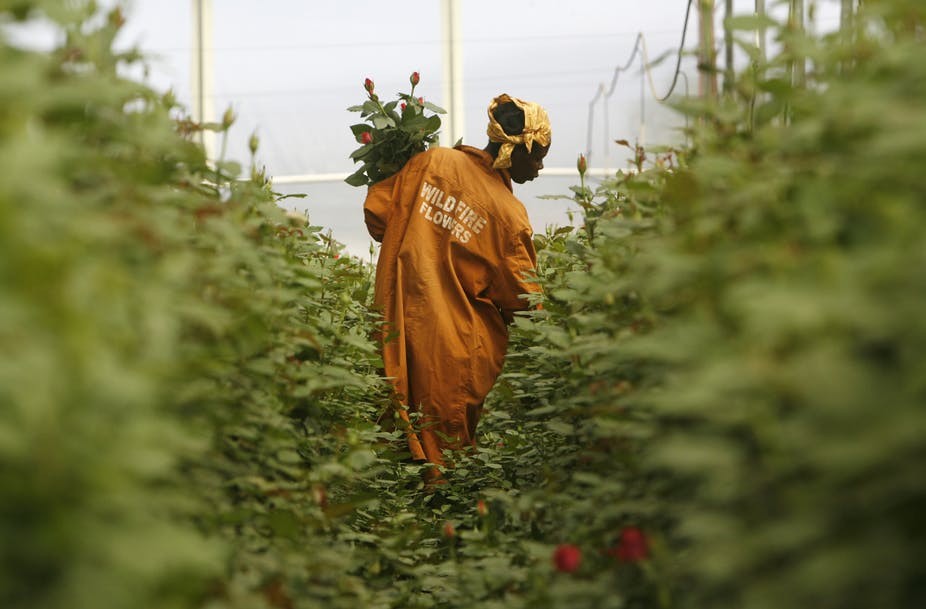Concerted campaign helps women in Kenya鈥檚 flower industry get a better deal
This Valentine’s Day florists are predicting sales of in the UK alone. But where do they all come from?
Kenya is second only to the Netherlands for flower , with a total of 13,013 tons per year. And because of globalisation and global value chains, the Netherlands itself imports most of its flowers from Kenya, with an of USD$1 billion in 2016.
In Kenya, led to it moving from 3.6% to 8.1% of world exports between 2001 and 2016. are to the Netherlands and the UK. An estimated 100,000 tons of flowers leave Kenya every year for these two markets. Over a 132,000 tons are exported worldwide every year. In recent years Kenya has moved away from exporting lower value to higher value stems and bouquets.
One of the groups of people to benefit from the burgeoning industry have been women. They form an estimated 75% of workers at production level in Kenya and have seen some over the years.
But it hasn’t been an easy journey. At the outset women faced systemic inequalities which made them vulnerable workers. These included poor labour conditions, the violation of health and safety rules and sexual harassment. The product upgrading, along with concerted campaigns by human rights activists, NGOs, trade unions and the buy-in of business led to a sea change in the women’s working conditions.
The reforms show that when a broad range of stakeholders come together substantive changes can be made in favour of vulnerable women workers. In line with the UN , big corporations can be transformative in contributing to social justice for women workers. In a collaborative effort, the business community has a great opportunity to step in and lead the change.
A long struggle for rights
In the early 2000s NGOs, human rights, civil society and trade union organisations in Kenya and Europe campaigned over poor labour conditions for women workers. These included women workers on constantly renewed temporary contracts, violations of health and safety rules in greenhouses and endemic sexual harassment by male supervisors.
In addition there were also often demands for unplanned overtime because of last-minute orders placed by buying companies. This caused childcare problems. Women were also subject to additional risks such as sexual harassment and long hours and night time journeys to and from work.
The range of actors involved in the campaign brought a raft of changes across the industry. Sound gender policies on workers’ rights, training, promotion and grievance procedures were introduced. Social auditing involving local NGOs, trade unions and human rights organisations helped identify specific issues facing women workers on particular farms.
Thanks to specific gender policies on workers’ rights and grievance programmes, as well as to a decisive product upgrading, many Kenyan flower growers underwent a crucial . This meant that women workers were now members of the unions, thus giving them access to .
The role players
Kenyan NGOs, trade union and human rights organisations played a critical role in raising issues. A complaint was made about supermarket sourcing to the UK , an alliance of companies, trade unions and NGOs that promotes respect for workers’ rights around the globe. This led to investigations and involved visits to Kenya. A number of changes resulted in the leading flower farms, bringing real change for women workers.
Gender committees were established on farms, providing a channel for women workers to voice grievances. Some supermarkets allowed longer lead times for delivery, assisting childcare responsibilities while reducing the risk of sexual harassment at night.
Improvements in Kenya’s employment law in 2007 also helped improve national labour standards. Over time, more women became supervisors and moved into managerial positions; and there was a significant reduction in reporting of labour abuse and sexual harassment. Procedures are now in place for reporting problems and for remedying them.
The business benefits of the changes also became clear. Improving the rights of a largely female workforce has led to lower labour turnover, more committed skilled workers, higher productivity and quality.
But there is still a long way to go: workers are working with trade unions and civil society organisations in their fight for a living wage and other rights.
Global responsibility
Corporations at the top of global value chains have a to stop exacerbating gender discrimination in their operations by factoring gender into the due diligence investigations they do into corporate human rights.
The first step is to recognise that protecting women workers’ rights is their responsibility. And that workplaces can be used as an engine for changing social norms and reducing gender inequalities.
At the same time, companies can lead the charge in finding viable solutions for protecting women workers’ rights. Tackling the root causes of gender inequalities, securing access to effective remedial processes and boosting regulations on sexual harassment can lead to fundamental and systemic change.
![]() Human rights abuses and sexual harassment can be tackled in global value chains. But for this to happen large corporations must take responsibility. In addition, a broad range of actors must be involved in securing real change for women workers, as Kenya has shown.
Human rights abuses and sexual harassment can be tackled in global value chains. But for this to happen large corporations must take responsibility. In addition, a broad range of actors must be involved in securing real change for women workers, as Kenya has shown.
, Research Associate in Business and Human Rights,
This article was originally published on . Read the .
